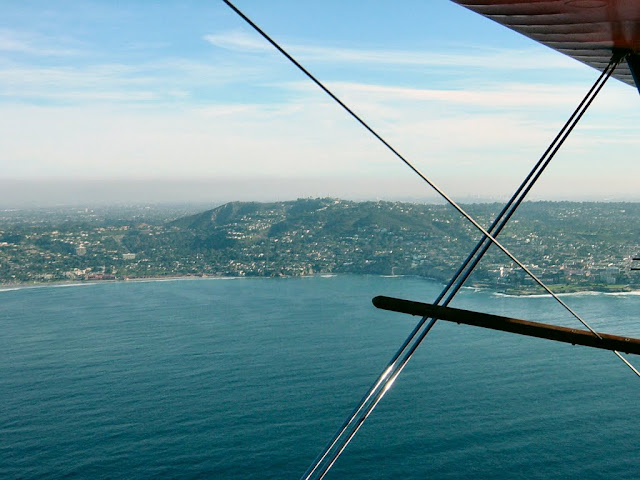On December 13 2003, I visited the McClellan-Palomar Airport, home to Barnstorming Adventures Ltd. Thanks to these fine folks, I spent about 40 minutes flying a restored 1929 Travel Air 4000 biplane over the Pacific coastline. Because most of my time was spent actually flying the aircraft, I took very few pictures.
NC674H is a 1929 Travel Air 4000 - a fabric-skinned historical artifact sporting a radial engine and a beautiful wooden prop. According to the folks at Barnstorming Adventures, this aircraft was originally flown by Chicago detectives and carried a bloodhound used to track the thugs that have become so emblematic of organized crime in early 20th century Chicago.
Once seated in the Travel Air, I looked to my right and noticed a T6 Texan sitting on the ramp nearby - another one of the toys belonging to Barnstorming Adventures.
Once established at a cruise altitude of 1500 feet, I took over the controls and directed the biplane south along the Pacific shoreline. Torn between wanting to sight-see and fly the airplane, I did several steep turns as we buzzed southward. At 85 mph, we would not even outrun a Cessna 150, but the ride was smooth, the airplane stable, and it was all tremendously fun.
La Jolla, home to the Pfizer R&D facility that brought me to California in the first place, sits on a peninsula that juts out into the Pacific Ocean. La Jolla marked the end of our southward trek; it was time to return to Palomar Airport. As we circled over the ocean, we watched a pair of dolphins playing below. Though difficult to see underwater, they would often break through the surface, streaking through the air momentarily before splashing back under the waves.
Once I acknowledged to Eric, the pilot in command, that I had captured a photo of La Jolla, he responded with "ok, your airplane". I took control of the stick again and began my customary scan for traffic. Immediately, I spotted a Piper Cherokee at 11 o' clock low climbing right toward us! Eric spotted him just as I did and immediately banked the biplane into a hard right turn. We later realized that we had been between the Piper and the sun, which probably made it virtually impossible for him to see us. A few minutes later, we spotted the Piper again, cruising along below us. Eric offered to take control again if I cared to snap a photograph of the, as he put it, "airplane that almost ruined [my] vacation".
I guided the biplane back to Palomar and flew the pattern until we were a few tens of feet above the runway. On short final, I surrendered the controls to Eric, who made a smooth wheel landing on the uphill grade of Palomar's runway 24. I couldn't have asked for a better way to spend a warm California winter afternoon!







On December 13, 1930, my father, age 16, had his second flight lesson in an aircraft registered as NC674H in Buffalo, New York. Could this be the same airplane, or do they change or reuse N-numbers?
ReplyDeleteInteresting question!
DeleteYes, N-numbers do get reused. In fact, the airplane I flew for my training was wrecked in 2005 and the N-number was reassigned to a 2011 Cessna 172. I tried to do a little research on this registration number, but was not able to find much information (perhaps because it’s an NC-number?).
Here’s a blurb on the history of the aircraft from the web, but it does not give much insight into whether the 1929 Travel Air always had that registration number. It says that the airplane was in Chicago in 1929, but not how long it remained there:
Barnstorming Adventures’ first Travel Air, NC674H, was built in 1929 as a Model 2000 with a 90-horsepower Curtiss OX-5, liquid-cooled, V-8 engine – the same engine that powered the famous JN-4 Jenny. NC674H was purchased by a Chicago-based detective agency after the infamous St. Valentine’s Day massacre in 1929, and was used to transport a bloodhound. Just prior to WWII, the engine was upgraded to a 220-horsepower Wright J-5 Whirlwind, air-cooled, 9-cylinder radial engine, similar to the one that powered the Spirit of St. Louis. This upgrade transformed NC674H to a Travel Air 4000. After WWII, NC674H was used as a crop-duster in Texas and Oklahoma, and the J-5 engine was replaced with a 225-horsepower Continental W-670, air-cooled, 7- cylinder radial engine. The aircraft was completely restored in 1992 with an overhauled and chromed W-670 engine, factory-original blue and orange colors, a new propeller, a 3-place intercom, and dual controls.
Love those photos. They take me back. I volunteered at Barnstormer Adventures during my teenage years from age 12-16.
DeleteThey let me and my friend fly in all of their aircraft and even co-pilot most of them in exchange for our help with various things such as loading the passengers and just being hangar rats.
I was a known as hangar rat and my buddy Steven was known as hangar mouse because he was shorter. He's taller than me now so it all worked out.
Those were some of the best days of my life and I'll never forget all the rides in the biplanes with the wind surrounding us and smelling the salt of the Pacific Ocean as we flew. Thanks for the article.